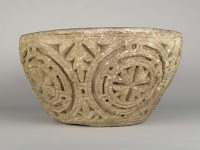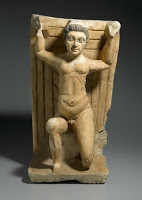Egypt


- Exhibition: Unearthing The Truth
Brooklyn Museum (Edna R. Russmann) Thanks to Lin Wang for the above link. Unearthing the Truth opens on Friday, February 13th. Now that this rather unusual exhibition is ready to go, I am glad to have this opportunity to talk about it a little. Most of...
- Exhibition: More Re Unearthing The Truth - Egypt’s Pagan And Coptic Sculpture
Suite101 (Stan Parchin) The exhibition, on view from February 13 to May 19, 2009, presents 30 Late Antique works (395-642 A.D.), many genuine, alongside reworked or repainted objects and a number of modern forgeries in an ambitious attempt to explain...
- Exhibition: More Re Fake Coptic Items At The Brooklyn Museum
Yahoo! News The Brooklyn Museum, which recently announced its prized collection of stone sculptures from ancient Egypt was cluttered with fakes, is planning an exhibit with these pieces to raise awareness of forgeries in the world's art collections....
- Fake Coptic Art In The Brooklyn Museum?
ARTINFO Edna Russmann, a curator at the Brooklyn Museum of Art, has said that about one third of the museum's Coptic art — early Christian Egyptian art — collection is fake, the Independent reports. Although chemical testing on the works has not...
- Exhibition: Coptic Sculpture In The Brooklyn Museum
Suite 101 (Stan Parchin) "Coptic Sculpture in the Brooklyn Museum" will present authentic Late Antique works with their modern-day replicas. Late Antique Egyptian sculptures (395-642 A.D.) and modern replicas are compared in an upcoming exhibition in...
Egypt
Exhibition: More re Unearthing the Truth - Egypt’s Pagan and Coptic Sculpture
Thanks to Sally Williams, Public Information Officer at the Brooklyn Museum, for sending me the following press release and photographs:
Brooklyn Museum Presents Exhibition of Genuine and Fake Late Antique Egyptian Sculpture
Unearthing the Truth: Egypt’s Pagan and Coptic Sculpture
On view February 13 through May 10, 2009
An exhibition of thirty works from the Brooklyn Museum’s permanent collection of Late Antique Egyptian stone sculptures (395–642 A.D.) that includes several examples of reworked or repainted works and some that appear to be modern forgeries, will be on view beginning February 13, 2008.
These ancient sculptures were carved from a soft Egyptian limestone and feature both pagan and Christian scenes and symbols. Some were tomb portraits of the deceased, other carvings decorated the tomb and were used in pagan and Christian cemeteries and in Christian churches and monasteries. The term Coptic, which describes some of the pieces, denotes the main and original branch of Christianity in Egypt.
Late Antique Egyptian sculpture was little known when it began to appear on the market shortly after World War II and into the 1960s and 1970s. At that time a number of pieces were acquired by the Brooklyn Museum. Gradually some scholars began to realize that the examples now in museums in both Europe and the United States included many modern imposters, but a comprehensive study has yet to be undertaken. Many experts believe that some of the forgeries were created upon remnants of ancient pieces and that very few pieces remain as they were originally produced in the period.
For a review of the Brooklyn Museum’s pieces, Curator of Egyptian Art Edna R. Russmann joined a number of outside authorities on Coptic art and on the sources of Egyptian stone. Much of that work is still ongoing. This exhibition focuses on the work done so far, and especially on the stylistic characteristics of the works, both ancient and modern.
The examples of the modern imitations are quite ambitious in scale and complexity and often depict unusual subjects and themes. Among the forgeries on view will be a female bust purporting to be Holy Wisdom holding an orb and staff; a limestone relief of the paralytic healed by Christ; and a sculpture depicting the Holy Family. What is striking about the fakes is that they place a greater emphasis on Christian iconography than the authentic works—a reflection of market demand for such imagery in Europe and North America.
The authentic sculptures include the bust of an unnamed Christian saint with a halo and holding a cross; part of a funerary relief representing the Nile god with his consort, the Earth goddess; and a funerary stela made for a three-year-old boy, the son of a Roman soldier who was stationed in Egypt.
The exhibition’s curator, Edna. R. Russmann, states, “It is my hope that by displaying the fakes alongside the genuine works, visitors will gain an understanding into how museums authenticate their collections and gain a better appreciation of the real Coptic art.”
Unearthing the Truth: Egypt’s Pagan and Coptic Sculpture is organized by Edna R. Russmann, Curator of Egyptian, Classical, and Ancient Middle Eastern Art, Brooklyn Museum.
A variety of public programs will be presented in conjunction with the exhibition. For more information visit www.brooklynmuseum.org.

Egyptian, Classical, Ancient Middle Eastern Art
43.55
Unknown Coptic artist
place made: Egypt, Provenance unknown
Column Capital
ca. 6th century C.E.
Late Antique Egyptian Period
Limestone
11 x 21 5/8 in. (28 x 55 cm)
Charles Edwin Wilbour Fund
Brooklyn Museum
43.55
Unknown Coptic artist
place made: Egypt, Provenance unknown
Column Capital
ca. 6th century C.E.
Late Antique Egyptian Period
Limestone
11 x 21 5/8 in. (28 x 55 cm)
Charles Edwin Wilbour Fund
Brooklyn Museum

Egyptian, Classical, Ancient Middle Eastern Art
62.44
reportedly from: Sheikh Ibada Egypt
Paralytic Raising His Bed
20th century C.E. (probably)
Limestone, painted
24 3/16 in. (61.5 cm)
Other (figure only): 21 1/16 in. (53.5 cm)
Base: 11 x 11 11/16 in. (28 x 29.7 cm)
Charles Edwin Wilbour Fund
Brooklyn Museum
62.44
reportedly from: Sheikh Ibada Egypt
Paralytic Raising His Bed
20th century C.E. (probably)
Limestone, painted
24 3/16 in. (61.5 cm)
Other (figure only): 21 1/16 in. (53.5 cm)
Base: 11 x 11 11/16 in. (28 x 29.7 cm)
Charles Edwin Wilbour Fund
Brooklyn Museum
- Exhibition: Unearthing The Truth
Brooklyn Museum (Edna R. Russmann) Thanks to Lin Wang for the above link. Unearthing the Truth opens on Friday, February 13th. Now that this rather unusual exhibition is ready to go, I am glad to have this opportunity to talk about it a little. Most of...
- Exhibition: More Re Unearthing The Truth - Egypt’s Pagan And Coptic Sculpture
Suite101 (Stan Parchin) The exhibition, on view from February 13 to May 19, 2009, presents 30 Late Antique works (395-642 A.D.), many genuine, alongside reworked or repainted objects and a number of modern forgeries in an ambitious attempt to explain...
- Exhibition: More Re Fake Coptic Items At The Brooklyn Museum
Yahoo! News The Brooklyn Museum, which recently announced its prized collection of stone sculptures from ancient Egypt was cluttered with fakes, is planning an exhibit with these pieces to raise awareness of forgeries in the world's art collections....
- Fake Coptic Art In The Brooklyn Museum?
ARTINFO Edna Russmann, a curator at the Brooklyn Museum of Art, has said that about one third of the museum's Coptic art — early Christian Egyptian art — collection is fake, the Independent reports. Although chemical testing on the works has not...
- Exhibition: Coptic Sculpture In The Brooklyn Museum
Suite 101 (Stan Parchin) "Coptic Sculpture in the Brooklyn Museum" will present authentic Late Antique works with their modern-day replicas. Late Antique Egyptian sculptures (395-642 A.D.) and modern replicas are compared in an upcoming exhibition in...
